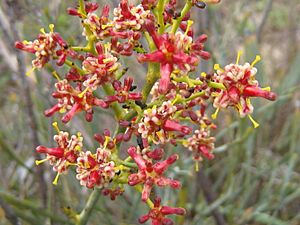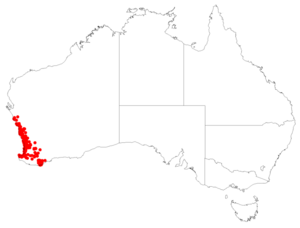Stirlingia latifolia facts for kids
Quick facts for kids Blueboy |
|
|---|---|
 |
|
 |
|
| Scientific classification | |
| Genus: |
Stirlingia
|
| Species: |
latifolia
|
 |
|
| Occurrence data from AVH | |
| Synonyms | |
|
|
The Stirlingia latifolia, often called blueboy, is a special plant that only grows in Western Australia. It's known for its interesting look and the way it can turn wall plaster blue!
Contents
What is Blueboy?
The blueboy plant is a type of shrub that stands upright. It can grow from about 20 centimetres (8 inches) tall up to 1.5 metres (5 feet) high. It has many stems, which can be up to 70 centimetres (2.3 feet) long. These stems grow from a special underground part called a lignotuber.
Its leaves feel a bit like leather and can be up to 10 centimetres (4 inches) long. They split into smaller parts up to three times, making them look unique. These leaves grow all the way up the stems. The plant's flowers grow in a cluster called a panicle on top of a tall stalk, which can reach 1.5 metres (5 feet) high.
Why is it Called Blueboy?
The common name blueboy is quite interesting! It comes from a cool fact: if you make wall plaster using sand from areas where Stirlingia latifolia grows, the plaster can turn blue. This is probably due to something in the plant or the soil it grows in that reacts with the plaster materials.
Where Does Blueboy Live?
This plant is found all over the western parts of Western Australia's Southwest Botanical Province. You can see it from Kalbarri in the north, all the way down to Albany in the south. In many places, it's very common!
Blueboy likes to grow in deep sand. You'll often find it among other plants in areas called heathlands, shrublands, and woodlands.
Is Blueboy in Danger?
Good news! The blueboy plant is not considered to be in danger. It's doing well in its natural habitat.
Images for kids




